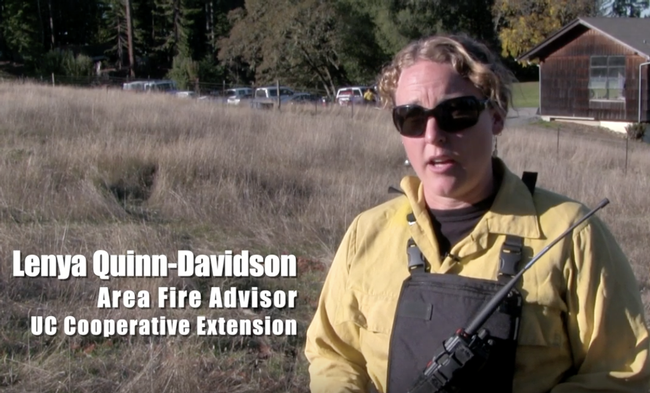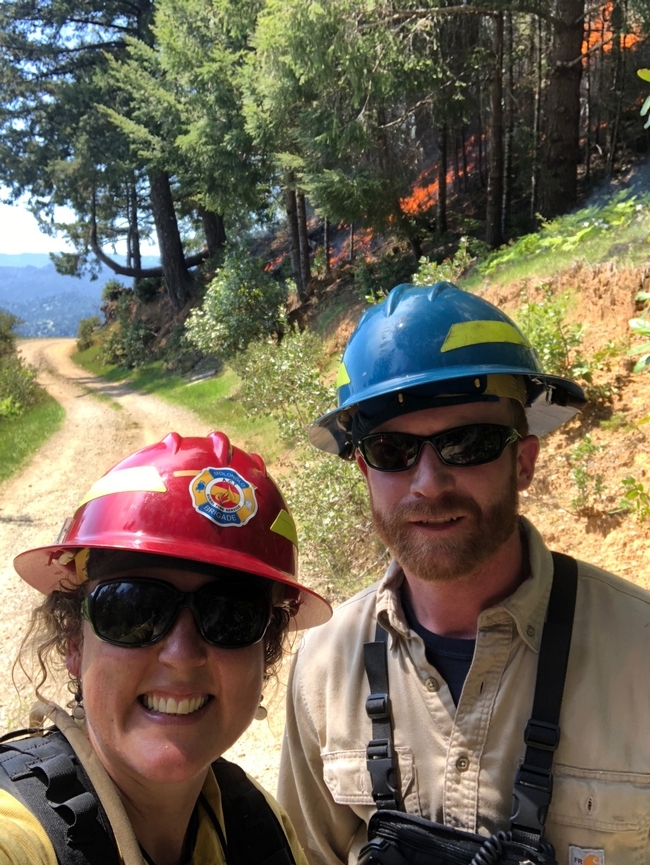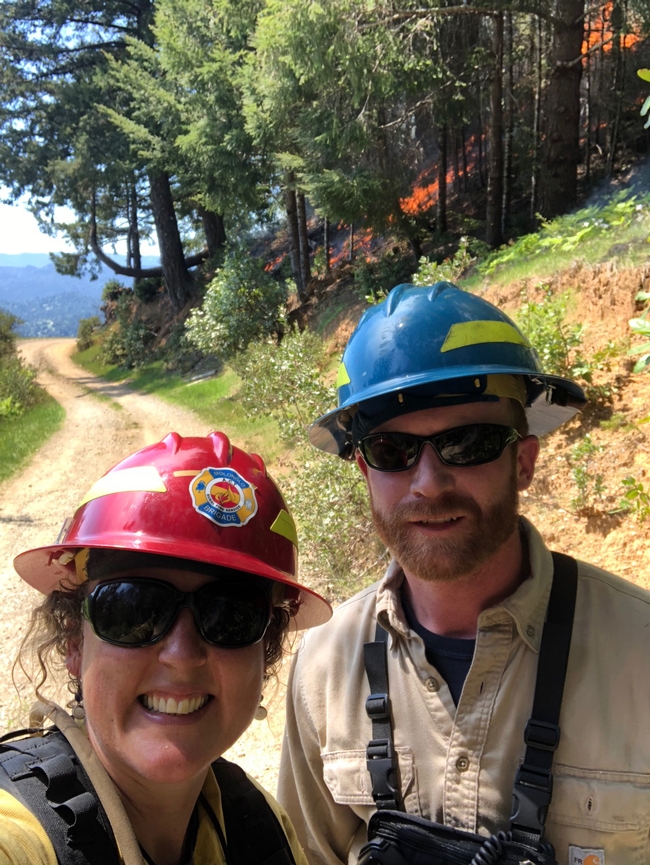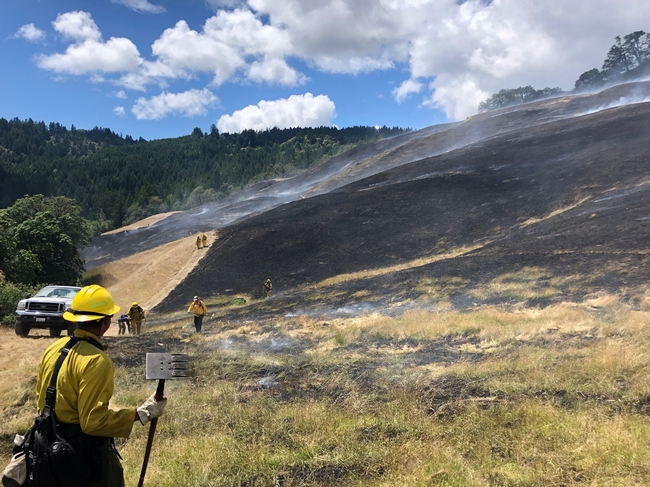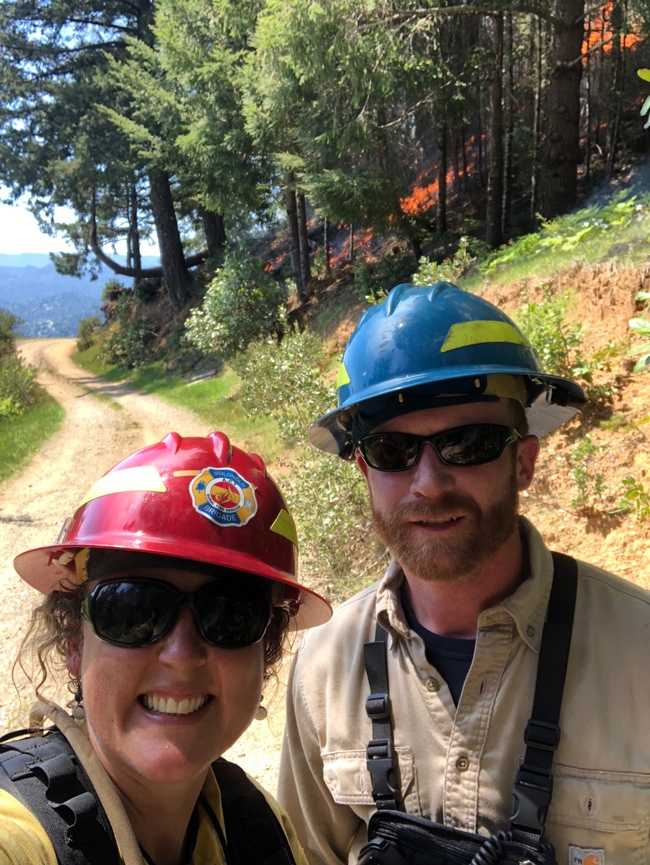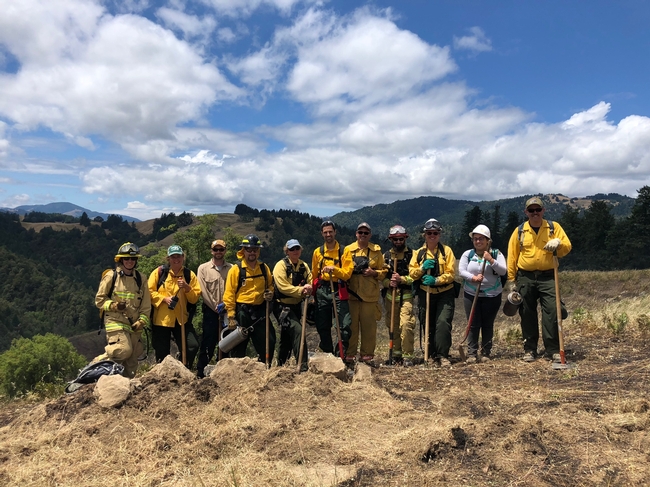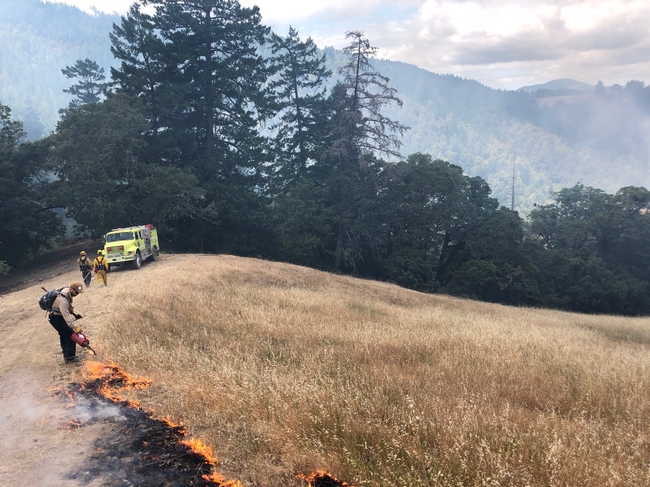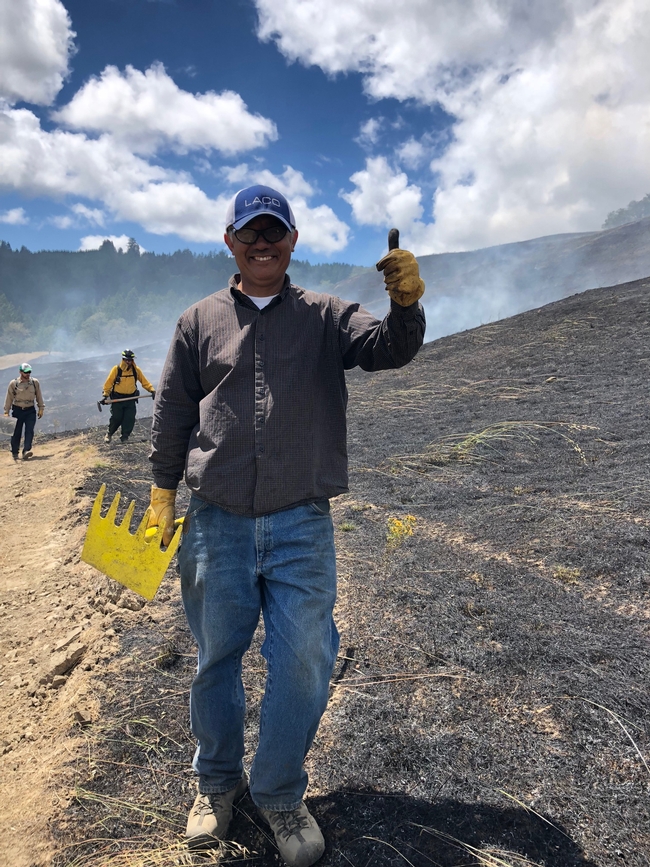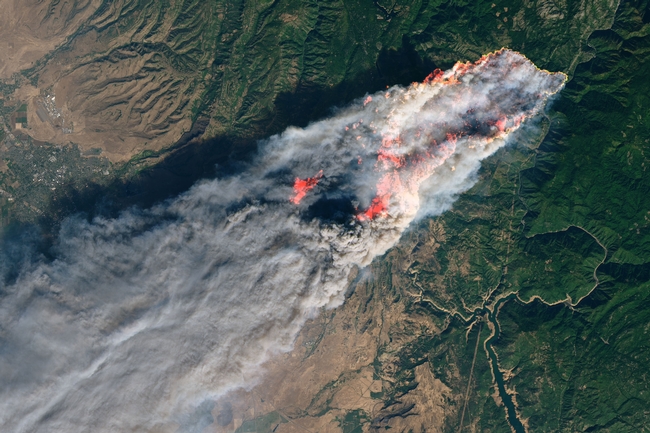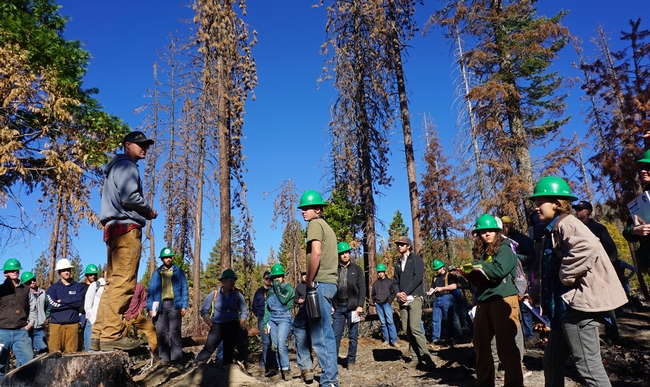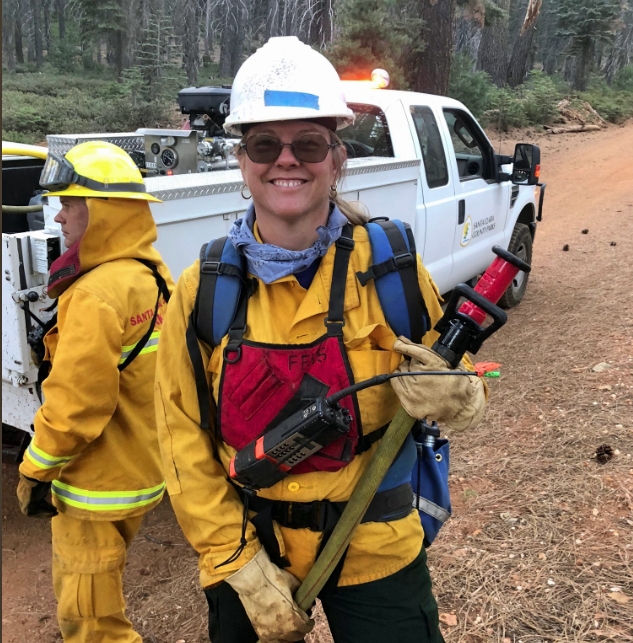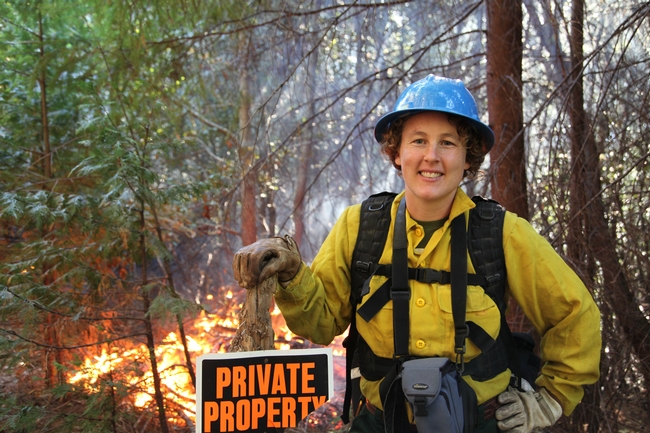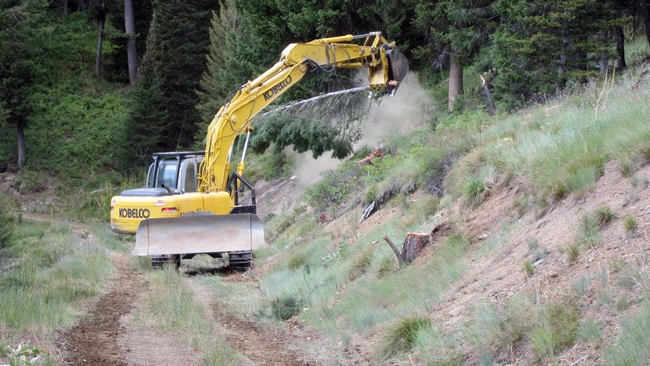Posts Tagged: Lenya Quinn-Davidson
Humboldt County’s Prescribed Burn Association teaches the value of fire
On a crisp and clear morning late last year, around 20 volunteer firefighters, landowners and community members gathered on a plot of land outside of the small rural community of Kneeland in Humboldt County. They listened intently to detailed instructions on how to safely burn 20 acres of private property that gradually rises on a hill before them. The volunteers gathered to learn how to successfully undertake a prescribed burn. It was all part of the ongoing education and training being conducted by Humboldt County's Prescribed Burn Association – the first of its kind west of the Rockies.
Lenya Quinn-Davidson and Jeffery Stackhouse, who both work for the UC Cooperative Extension in Humboldt County, developed the program in 2017 and have seen it steadily grow ever since. The association is comprised of landowners, nonprofits, volunteer firefighters and other community members who work together to carry out prescribed burns on private land. Until the association was created, most landowners and community members had lacked access to prescribed burn information and training.
“Fire is a natural part of California's landscape. Prescribed fire is a way for us to bring fire back to the landscape as a natural process under controlled conditions. We can choose the weather, we can choose how it's going to burn,” says Quinn-Davidson. “Private landowners have largely been left out of the fire picture and we realize that is a big part of the problem.”
The goal of the prescribed burn on that October day was to eliminate an invasive type of tree that was overtaking the grassy hill and restore the land to a state where native oaks can thrive once again. The property owners are receiving the same training as the volunteer firefighters on hand. Beyond eliminating invasive species, the association is utilizing prescribed burns to reduce fuels to prevent future wildfires, as well as restore wildlife habitat. But most importantly, the training and education empowers landowners and others to reconnect with fire as a management tool.
Will Emerson is an assistant fire chief for the volunteer Bell Springs Fire Department in northern Mendocino County. He and his three colleagues made the 2.5-hour trip to participate in the prescribed burn training session in Humboldt County. He sees the trainings as a “really great experience” for volunteer fire departments, some of which have new trainees who have never worked a fire before.
“It's excellent training for them — just to get comfortable working with fire,” Emerson says.
The concept of a prescribed burn association is catching on. Quinn-Davidson and Stackhouse have presented the Humboldt County model to numerous counties around the state, and new associations are cropping up around California.
“We use our program to train people, to inspire people, to empower people,” Quinn-Davidson says.
The value of Humboldt County's Prescribed Burn Association goes beyond the training it provides. Quinn-Davidson and Stackhouse view the association as a “community cooperative,” bringing together groups that have traditionally been at odds. At any training session you may find volunteers from the ranching or timber industry, environmentalists or cannabis growers.
“Instead of being on opposite sides of an issue, people are gaining understanding for the other side,” Stackhouse says. “It has opened the door for real, honest communication between different groups that otherwise would not be happening. Having people work together who have been on different sides of the community really is amazing.”
Quinn-Davidson agrees. “We are building community and we are using fire as this positive, synergistic thing,” she concludes. “And I feel so positive about it.”
The CSAC Challenge Awards were created in the early 1990s to recognize county innovation and best practices. Humboldt County's Prescribed Burn Association is a recipient of a 2019 CSAC Challenge Award – one of only 18 Challenge Awards presented statewide out of 284 entries.
To view a video of this program on YouTube, click here.
Power outages may put too much emphasis on one cause of wildfire
While many California communities have been left without power, UC Cooperative Extension fire scientist Lenya Quinn-Davidson worries that last year's Camp Fire has put too much focus on utility companies as the cause of fires, reported Tara Law in TIME.
Major fires are sometimes caused by utilities, but there are many other potential causes, including lightning, arson and sparks from dragging chains. All of these factors, are compounded by "lack of fuel management, poor land-use planning, and homes that aren't ready for fire and aren't resilient to fire," Quinn-Davidson said.
Power outages can complicate response and evacuation efforts should a fire break out, Quinn-Davidson said. Phone lines have been jammed during this week's outages and people have had trouble communicating with loved ones.
“If a fire starts because of other causes — which could easily happen under severe conditions — now we have no way to communicate,” she told the TIME reporter. “Seriously, like, if this power outage happened when the Carr Fire (sparked by a vehicle) happened — how would you evacuate people? That's completely possible. You could have a power outage and have a fire start from a roadside cigarette. Or arson. Or anything. And then what?”
The TIME article also quoted Jeffrey Stackhouse, UCCE livestock and natural resources advisor in Humboldt and Del Norte counties, about the sweeping power outages.
“People are freaking out around here,” he said.
Nevertheless, Stackhouse and Quinn-Davidson agree that scheduled power outages shouldn't be eliminated as a tool for preventing fires. They believe outages should be used sparingly, and in conjunction with preventative measures, such as fire-proofing homes and managing land.
“The disruption is pretty huge for something we're not sure is going to prevent a major wildfire. The actual likelihood of that event was not equal to the impact that this is having,” Quinn-Davidson said.
Read about Quinn-Davidson and Stackhouse's efforts to improve fire resilience in Humboldt County by establishing a prescribed burn association.
California’s first Prescribed Burn Association shows why we need more in the state
California's 2018 wildfire season was the deadliest and most destructive the state has ever seen. Even before the flames were extinguished, politicians, researchers, foresters, firefighters, insurance and utility company representatives, homeowners and landowners in the state's wildfire-prone areas were trying desperately to figure out how such devastation could be prevented in the future.
One reason for the destructive fires is a 100-year history in California of aggressive fire suppression. Most of the state's natural ecosystems evolved over millennia with periodic fires. Without fire, natural areas build up a great deal of vegetation – trees, shrubs, leaf litter and pine needles – that once ignited, can fuel a raging blaze.
Two UC Cooperative Extension advisors in Humboldt County believe the best way to bring back natural equilibrium on the land is by bringing back fire, and they believe it can be done in a way that is safe, effective, affordable and even fun.
Prescribed fire is part of California's past. Native Americans used fire to favor the plants and trees that provided their most nutritious foods, to open up areas for ease of travel and to attract game. In the 1980s, the California Department of Forestry and Fire (CAL FIRE) launched a Vegetation Management Program to share the cost and liability of prescribed fire on private land. At the height of the program, 65,000 acres of private lands were burned per year. However, by the mid-2000s, the agency had cut program funding, and private lands burning reduced to less than 5,000 acres per year in 2015. CAL FIRE is currently revamping their Vegetation Management Program, but UCCE experts say other pathways are also needed to regain ecosystem function on California's wildlands.
Born and raised in northern Californian, Lenya Quinn-Davidson, UCCE fire advisor, and Jeff Stackhouse, UCCE livestock and natural resources advisor, were deeply concerned about habitat loss and fuel buildup on private lands in Humboldt County. They investigated a concept being implemented successfully in other parts of the country, the formation of Prescribed Burn Associations (PBAs).
Creating California's first Prescribed Burn Association
The members of PBAs pool their resources and energy to conduct burns to maintain productive grasslands, enhance wildlife habitat, and ensure safer communities. In 2018, Quinn-Davidson, Stackhouse, Cocking and Hunt pulled together fellow Humboldt County ranchers, volunteer firefighters, non-profit organizations, and other community members to form the first Prescribed Burn Association in the western United States.
The Humboldt County Prescribed Burn Association has a president, board of directors, a treasurer and 85 members.
“More than half of the members are not landowners,” Stackhouse said. “People have houses in town, but want to go outside and experience land improvement on other people's property.”
To join the PBA, individuals pay $25 per year; ranches, timber companies and non-profit organizations pay $200 per year; and volunteer fire departments join free.
“People are willing to pay member dues to be a part of this community experience, get the training and to feel positive about fire, not afraid of it,” Quinn-Davidson said.
The PBA provides training, equipment and labor to safely use fire and meet permit requirements. So far, the Humboldt County PBA has burned 1,022 acres. And after each burn, they celebrate with food and drink.
The PBA is providing a space for a community of cooperation to grow. Groups and individuals with views that previously seemed miles apart – environmental activists, long-time ranchers, industrial timber organizations and well-established environmental organizations – are forging new alliances.
“It's interesting to see different groups meeting and burning with each other, to listen to them speak from their corners of the universe, giving each other room to speak and actively listening,” Stackhouse said.
The association is so successful, Stackhouse and Quinn-Davidson invited their UC Cooperative Extension colleagues from across the state to Humboldt County for a four-day workshop to learn how they might be able to replicate the concept in other fire-prone areas of California.
“We led a training and conducted three consecutive burns totaling over 100-acres,” Quinn-Davidson said.
UCCE livestock advisor in San Benito County, Devii Rao, attended the workshop.
“As a total novice, I received training and feel more confident about use of personal protective equipment, how to use a drip torch, hand tools, a water tank/pump/hose, and how to start developing a Prescribed Burn Association (PBA) on the Central Coast,” Rao said.
Another participant, UCCE forestry advisor Yana Valachovic, valued the opportunity and believes events like these could help solve a serious problem facing California.
“Talking about the use of prescribed fire in the abstraction does not move the meter,” she said. “California desperately needs experiences like this to empower community leaders and reincorporate fire into our management tool boxes.”
About UC ANR
UC Agriculture and Natural Resources (UC ANR) brings the power of UC research in agriculture, natural resources, nutrition and youth development to local communities to improve the lives of all Californians. Learn more at ucanr.edu.
For more California wildfire information and to find local UC Cooperative Extension fire experts, see the UC Agriculture and Natural Resources' Fire in California website.
Catastrophic wildfires and climate change lead to growing acceptance of ‘pyrosilviculture’
For millennia, fires periodically burned through California forests, thinning trees, reducing shrubbery and clearing out downed branches and debris. Without periodic fire, the forests became more dense, with spaces between large trees filling in with a thick carpet of duff, seedlings and shrubs.
As a result, today's forests are prone to more intense and damaging fires, like the Rim Fire, King Fire, and — most recently — the Camp Fire in Butte County. These fires are burning with unprecedented severity and speed, threatening large swaths of forest, towns, and even urban areas.
Using fire as part of forest management is not a new concept. Native Americans were known to burn brush to open up hunting grounds and clear shrubbery for gathering. Decades ago, iconic Berkeley forestry professor Harold Biswell said, “Fire in the Sierra Nevada is as important as rain.”
Competing forces, however, pushed foresters and fire officials toward fire prevention and suppression, particularly the cataclysmic fires of the early 20th century that leveled entire towns and left dozens of residents and firefighters dead. The fear of out-of-control blazes and the perceived damage to timber resources launched a war on fire that has lasted a hundred years. Some forest managers are urgently trying to negotiate a truce.
Making peace with fire and turning it into a useful tool, rather than a raging threat, was the objective of an October meeting in Shaver Lake of UC Cooperative Extension forestry and natural resources scientists, Southern California Edison forest managers, CALFIRE officials and U.S. Forest Service representatives.
The event also raised awareness of “pyrosilviculture,” a new forest management term coined by UC fire scientist Rob York to emphasize the importance of fire in silviculture, the management of forests for wood.
Forests have myriad benefits – recreational, environmental and economic. Nature lovers value the whisper of pine trees in the wind and green shade over hiking trails and ski slopes. Owls, bears, deer and other wildlife make their homes among firs, pines, oaks and cedars. Forests stabilize mountain slopes, which store water as snow for agriculture and drinking. People build their homes, businesses and schools out of the planks and boards cut from the straight, soft wood of conifer trees.
The value of California forest products was about $429 million in 2017, according to the USDA. Because fires can damage and destroy trees, the timber industry has historically been reluctant to use fire as a tool. That's changing.
“Fire is such an important ecological process, you can't manage for timber without fire,” York said.
York is the manager of the Blodgett Forest Research Station, UC Berkeley's 4,000-acre mixed conifer and oak forest near Georgetown where researchers study forest management practices for increasing timber yield while taking advantage of fire to enhance forest health and make forest stands more resilient to wildfire.
Controlled burning can be used to treat fuels and reverse these trends, but it has been inhibited by a number of barriers, including landowners' concerns about liability, risk aversion among fire management agencies, narrow burn windows, air quality limitations and other regulatory challenges. Now, public demand for prescribed fires is growing.
“I believe what moved the needle was, for several years in a row, there were high-severity fires in the news,” York said. “Wildfires were in the public zeitgeist. People began asking, ‘Why aren't we doing more prescribed fire?'”
Climate change is also intensifying the interest among the public and silviculture professionals. Because California is getting warmer and fire seasons are growing longer, high-severity fires are expected to increase.
“There would logically be a tipping point. Even though we reduce the growth of trees when we use fire, if it can prevent the loss of the forest entirely, it would be meeting the timber objective,” York said.
The vast tree die-off during the 2011-2016 drought was another jarring sign that the Sierra Nevada ecosystem is out of balance.
The U.S. Forest Service, which manages 20 million acres of forest in California, is using prescribed fire to reduce fire risk on federal forestlands, but scientists say it's not nearly enough to reduce the threat of catastrophic wildfire. CAL FIRE is ramping up its controlled burn efforts, but it will take time to address far-reaching areas of overgrown forestlands. The agency sometimes uses mechanical measures such as mastication and chaining before burning to pre-treat fuels and prepare units for burning.
“We need to work around communities first, and then move out to the wider landscape,” said CAL FIRE division chief Jim McDougald. “If a prescribed fire moves into a subdivision and burns houses, we take 100 steps back.”
“Burning is a key element of forestland management and it can be safe if done properly,” Kocher said. “We provide classroom instruction and invite participants to join a live prescribed fire at Blodgett Forest as part of their training so they become familiar with the process.”
At the training sessions, UC Cooperative Extension advisor Lenya Quinn-Davidson said that in some cases, private landowners can conduct burns themselves. In her hometown in Trinity County, many ranchers and landowners conduct small broadcast burns to reduce fuels and improve forage. These burns are typically quite small and usually conducted in the winter.
“This can be a good option for landowners who wish to burn small areas, but we need other options for bigger, more complex burns” Quinn-Davidson said.
In other parts of the country, landowners have formed Prescribed Burn Associations (PBAs) that allow landowners to work with neighbors and other community members on controlled burns, sharing equipment and labor while developing skills. The PBA model provides a low-cost, grassroots option for prescribed burning, and empowers landowners to work together, and with other key experts and partners, to bring fire back to the landscape, says Quinn-Davidson.
“People are desperate to do something about fire, and the PBA model gives them an option to actively engage with each other and with fire as a tool—it's very empowering,” said Quinn-Davidson.
Federal government proposes new fuel breaks to manage wildfire
The Federal Government has proposed spending $55 to $192 million to clear large swaths of land in the Western U.S. to create fuel breaks that slow the spread of wildfire, reported Brady McCombs of the Associated Press. The fuel breaks will be managed by the Bureau of Land Management in Idaho, Oregon, Washington, California, Nevada and Utah.
Fuel breaks are a useful tool if used along with other wildfire prevention methods that can keep firefighters safer and potentially help out in broad scopes of land because they are long and thin, said Lenya Quinn-Davidson, the area fire advisor for University of California Cooperative Extension. They can be especially helpful by providing perimeters for prescribed burns. But they must be in the right places, she said.
The article said the BLM has done about 1,200 assessments of fuel breaks since 2002 and found they help control fires about 80 percent of the time. The new fuel breaks will be 500 feet wide or less and created along highways, rural roads and other areas already disturbed.


